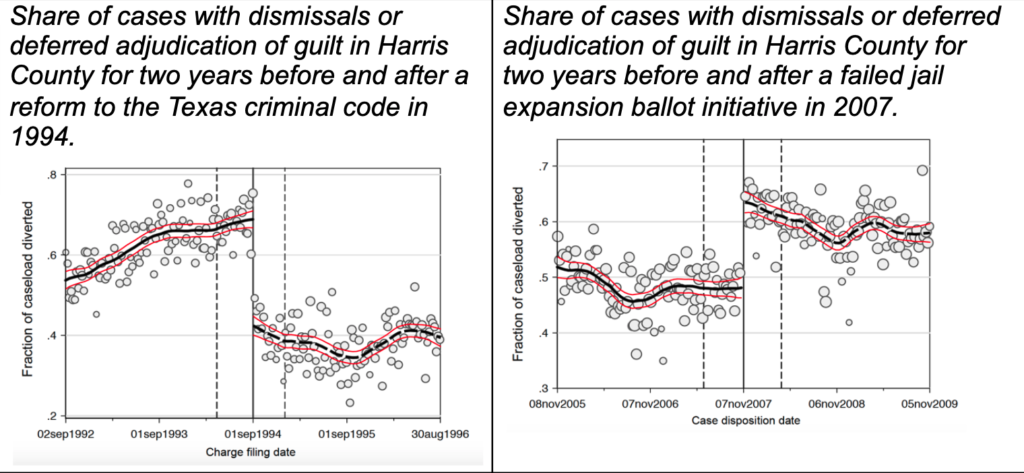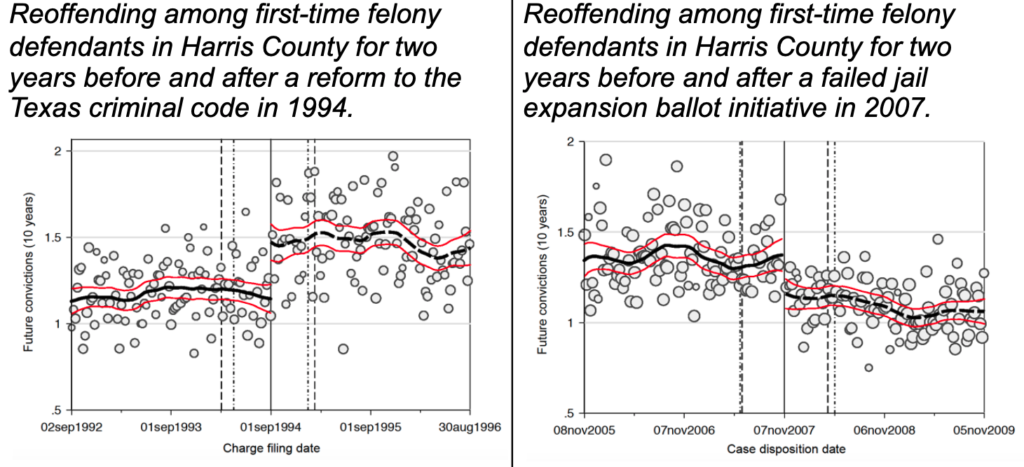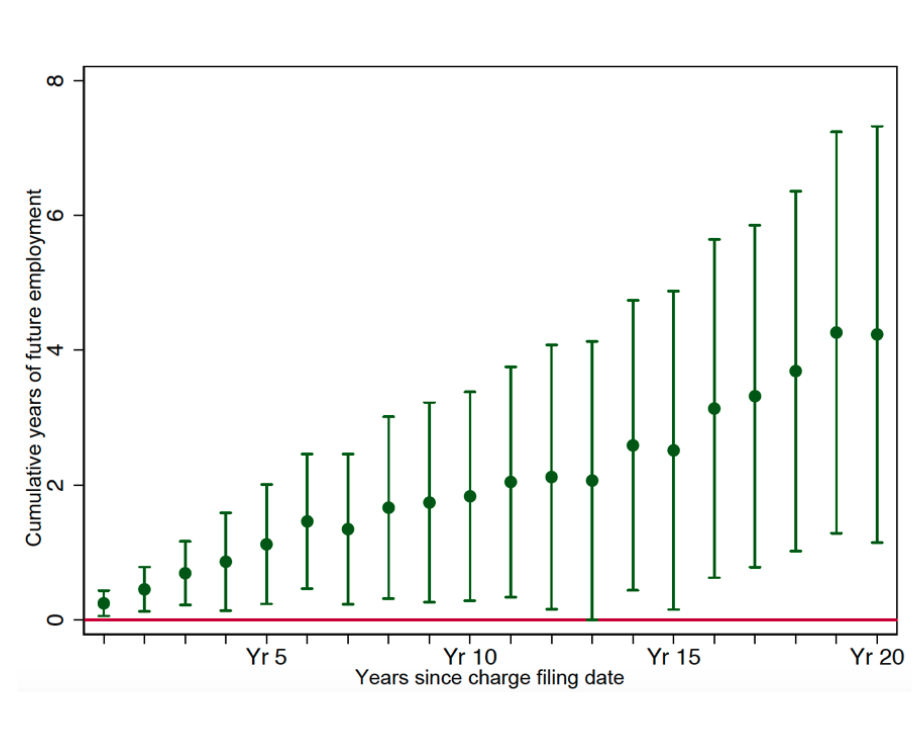Summary
Public officials have made substantial efforts over the past decade to reform criminal justice policy. The general trend in the US has been towards more leniency, especially for first-time and low-risk defendants, with ‘diversion’ emerging as a popular option.
Diversion is a practice where a police officer, prosecutor, or judge provides an opportunity for an individual charged with a criminal offense to avoid a conviction either through a dismissal of the charge or by some alternative measure. Despite the growing popularity of such programs, until now not much has been known about the impact of diversion on future behavior.
A recent study estimates the causal impacts of a diversion program offered to most first-time felony defendants in Harris County, Texas (which covers the Houston area). This program – known locally as ‘deferred adjudication’ – allows individuals to remain free of a felony conviction if they can successfully complete a period of community supervision. This diversion option is similar to many other programs administered by prosecutors and judges across the US, Europe and elsewhere.
The researchers find that providing these individuals with an opportunity to avoid a felony conviction cuts their reoffending rates in half while also boosting their quarterly employment rates by nearly 50% over a 10-year follow-up period. Those at the highest risk of reoffending – young black men with prior arrests – gain the most from diversion.
What explains these improved outcomes? Investigation of potential mechanisms strongly suggests that avoiding the stigma associated with a felony conviction plays a key role in improving labor market outcomes and reducing offending.
Stigma as a key driver is supported by several findings. First, diversion leads to work in industries that are less accessible to applicants with felony conviction records. Second, there are not similar improvements among diverted individuals who already have a felony conviction.
What’s more, both those diverted and those convicted typically face similar community supervision requirements and do not experience significant differences in time spent incarcerated. Therefore, the benefits of diversion do not appear to be heavily influenced by the inability to work or reoffend due to imprisonment.
Deferred adjudication in Texas represents the largest diversion program in the US with over 200,000 participants in 2017 (the most recent year with state-wide caseload data available). Based on these findings, this program may serve as a good model for other jurisdictions considering an expansion of diversion options for low-risk or first-time criminal offenders.
Main article
A criminal conviction can severely limit an individual’s future opportunities, especially in the US where the majority of employers conduct criminal background checks. This column reports a recent study that measures the causal impact of a ‘diversion’ program that delivers the same punishment – typically remaining in the community under the supervision of a probation officer – but provides people with an opportunity to avoid a conviction. The researchers find substantial reductions in future criminal offending as well as improvements in labor market outcomes. Their results suggest that expanding diversion programs could lead to higher rates of rehabilitation and greater benefits for society.
Public officials are increasingly diverting people from the criminal justice system, usually to help them to avoid a criminal record and its associated consequences. The practice has become an important part of recent efforts to reform criminal justice policy, and it often enables corrections systems to conserve scarce resources. Despite the growing popularity of criminal justice diversion interventions around the world, little is known about their impacts on future behavior.
Potential effects of a second chance
The opportunity of a ‘second chance’ by avoiding a criminal conviction can affect future behavior in a variety of ways. On one hand, it increases job prospects, since a criminal conviction can severely limit employment opportunities, especially in places where criminal background checks are used to screen applicants (Pager, 2003; Raphael, 2014). A recent US study finds that job applicants with felony conviction records are 63% less likely to receive a callback for an interview compared with people who don’t have a record (Agan and Starr, 2017).
More work also means less crime; a large body of empirical research consistently finds decreases in crime following increases in employment opportunities (see Chalfin and McCrary, 2017, for a review).
Providing people with a ‘second chance’ to avoid the consequences of a conviction is widespread in many criminal justice systems
On the other hand, diversion represents a lesser punishment, which could increase future offending. Recent work finds evidence of this effect, known as ‘specific deterrence’, for individuals arrested for drunk driving (Hansen, 2015). Those receiving a less severe punishment may be more likely to reoffend. Moreover, we may also expect higher levels of first-time offending as individuals learn about a more lenient punishment regime through a ‘general deterrence’ mechanism (Becker, 1968).
Deferred adjudication
In our recent study (Mueller-Smith and Schnepel, 2020), we use detailed administrative data from Harris County, Texas (which covers the Houston area), to evaluate the causal impact of a diversion program available to a large fraction of felony defendants in the state.
This program – known locally as ‘deferred adjudication’ – allows individuals to remain free of a felony conviction if they can successfully complete a period of community supervision. This diversion option is similar to many other programs administered by prosecutors and judges across the US, Europe and elsewhere.
We find that diversion leads to a dramatic reduction in reoffending. The total number of future convictions falls by 75% over a 10-year follow-up period for our sample of deferred defendants compared with those who receive a felony conviction. Our results also suggest large improvements in labor market outcomes, including a 50% increase in formal employment rates.
A diversion program in Texas – ‘deferred adjudication’ – allows individuals facing their first felony conviction to avoid the stigma
Measuring the impact of diversion
To measure the causal impacts of diversion, we use two sudden shifts in the use of diversion options that each approximate an experiment where the ‘treatment’ is randomly assigned to eligible felony defendants. Figure 1 illustrates these changes by displaying the fraction of the first-time felony defendant caseload diverted away from a felony conviction during each week for two years before and after the changes in policy.
Figure 1: Share of cases with dismissals or deferred adjudication of guilt

The sharp decline in diversion (or increase in convictions) during September 1994 depicted in the left-hand chart followed a revision to the criminal code in Texas that drastically reduced the use of diversion among judges and prosecutors. We plot outcomes by the date charges are filed for this experiment since the reform applied to all offenses committed on or after 1 September 1994. The result of this policy change was a 24 percentage-point decline in the fraction of cases diverted for charges filed after 1 September 1994 compared with the period just before the effective date of the policy change.
The right-hand chart in Figure 1 demonstrates a large shift in the opposite direction in 2007. This increase in the use of diversion for first-time felony defendants arose from the narrow failure of a jail expansion ballot initiative in Harris County on 6 November 2007. The following week, diversion among first-time felony defendants increased from less than 50% of the caseload to roughly 65%. This shift is driven by a change in judicial decisions so we plot outcomes based on case disposition dates for this 2007 experiment.
The diversion program leads to dramatic reductions in reoffending, plus lasting improvements in employment and earnings
On either side of these dramatic shifts, we do not find meaningful differences in the observable characteristics of defendants. In other words, defendants appearing in court in August 1994 were indistinguishable from those appearing in September 1994 with regard to their gender, age, race/ethnicity, or prior criminal histories. These patterns provide strong support for our assumption that individuals arrested before or after the policy change would be likewise indistinguishable in unobservable characteristics.
This key assumption enables a ‘regression discontinuity’ empirical methodology to evaluate the causal effects of diversion in this setting. This methodology approximates a randomized control experiment for defendants appearing in court around these thresholds. Since the change in the probability of treatment (diversion) is unrelated to other factors that influence outcomes, we can interpret changes in outcomes as being caused by the change in the probability of diversion.
Reoffending effects
Figure 2 depicts the changes in reoffending associated with the dramatic changes in the use of diversion. When the probability of diversion drops in September 1994, we observe a very large increase in future criminal offending among those appearing in court after the reform.
Here, we measure future offending by counting the number of convictions of any type over a 10-year period. When the probability of diversion jumps up following the failed jail expansion ballot initiative in November 2007, we see a sharp decrease in future criminal offending for defendants exposed to the higher probability of diversion.
Figure 2: Reoffending among first-time felony defendants

The changes in reoffending depicted in Figure 2 represent the overall effect of the policy change on first-time felony defendants in Harris County. Of most interest to us is the causal impact of diversion at the individual level. We estimate such an effect using what is known as a ‘fuzzy regression discontinuity’ empirical specification.
This method allows us to measure the effect of treatment (diversion) for the defendants who are affected by the policy change. In other words, we measure the treatment effect for defendants who would not be diverted if appearing in October 2007, but who would be diverted in November 2007 after the increase in leniency following the failed jail expansion ballot initiative.
Through this method, we find 1.6 and 1.7 fewer future convictions over a 10-year follow-up period associated with diversion for individuals appearing in court around the 1994 and 2007 shifts, respectively. These impacts represent declines in future convictions of around 75% from levels of offending we would expect to see in the absence of diversion.
Those at the highest risk of recidivism – young black men with one or more misdemeanor convictions – gain the most from diversion
Employment effects
While less precise, we also find evidence that diversion leads to improvements in employment outcomes. For the group affected by the 1994 penal code reform, we estimate an increase in average quarterly employment by 18 percentage points, or approximately 50% relative to the rate of employment expected for this group without the diversion treatment over the 10-year follow-up period. We also find an employment effect that is very similar in magnitude but not statistically significant for those diverted after the failed ballot initiative in 2007.
The importance of these employment impacts is illustrated in Figure 3, which presents the cumulative effect of diversion on years of employment over a 20-year follow-up period for those diverted around the 1994 policy change.
Diversion results in more than four full years of employment in the 20 years following treatment. This is an enormous impact and suggests that diversion can permanently place an individual on a different trajectory in terms of formal employment and earnings. Our analysis evaluating the impact on other labor market outcomes suggests that diversion enables individuals to find better and more stable jobs.
Figure 3: Estimated effect of diversion on cumulative years of formal employment for first-time felony defendants around the 1994 policy change

Those who are at the highest risk of recidivism – young black men with one or more misdemeanor convictions – gain the most from diversion. This is a group often discussed as over-policed in the US. Our results indicate that intervening for this disadvantaged population at a critical moment (when they are being charged with their first felony offense) could significantly improve their life course.
The key role of avoiding stigma
Given these profound benefits associated with diversion, it is important to understand the likely explanations for improved outcomes. Our investigation of mechanisms strongly suggests that avoiding the stigma associated with a felony conviction plays a key role in improving labor market outcomes and reducing offending.
Stigma as a key driver is supported by several findings. First, we find that diversion leads to work in industries that are less accessible to applicants with felony conviction records.
Second, we do not find similar improvements among diverted individuals who already have a felony conviction. Moreover, both those diverted and those convicted in our setting typically face similar community supervision requirements and do not experience significant differences in time spent incarcerated. Therefore, the benefits of diversion do not appear to be heavily influenced by the inability to work or reoffend due to imprisonment (known as an ‘incapacitation’ channel).
Avoiding the stigma associated with conviction is key to improving labor market outcomes and reducing offending
This finding of stigma as a focal mechanism contributes substantially to prior studies that discuss the impact of a prior conviction on reoffending and labor market outcomes. In particular, our estimates suggest that the negative impact of a conviction on employer callback rates, as found in the extensive audit-based research (Pager, 2003; Agan and Starr, 2017), extends to actual employment and earnings outcomes.
Conclusions
Given the trajectory towards more leniency in the US criminal justice system, our results suggest that increases in diversion options may lead to lower rates of reoffending and higher rates of rehabilitation in the coming years. But it is important to note that overall criminal activity could increase in response to softer punishment (Becker, 1968).
While we cannot test directly for these general deterrence effects, we do not expect these effects to outweigh the reductions in offending among those diverted based on many studies documenting a weak, if any, response to changes in expected punishments (see Chalfin and McCrary, 2017, for a review).
To the best of our knowledge, no prior research has found similarly large or lasting effects for such a low-cost intervention in the justice system. While much has been written about what does not work in criminal justice policy in the US, our study provides compelling evidence for a successful intervention that both improves defendant outcomes and saves public resources. Diversion can be implemented without significant investments or changes to current infrastructure, making it a potential solution for criminal justice reform in the US and around the world.
Deferred adjudication in Texas represents the largest diversion program in the US with over 200,000 participants in 2017 (the most recent year with state-wide caseload data available). Based on our findings, this program may serve as a good model for other jurisdictions considering an expansion of diversion options for low-risk or first-time criminal offenders.






